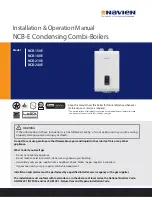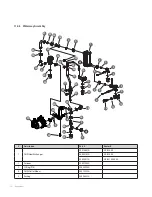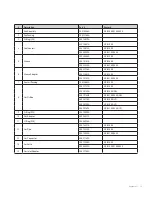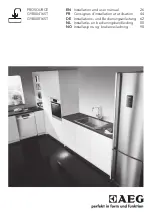
80 Appendixes
11.6 Outdoor Reset Control (Available with
Optional Outdoor Temperature Sensor)
The Outdoor Reset Control feature may be used to enhance energy
efficiency while maintaining optimal heating performance. With
the Outdoor Reset Control, the space heating temperature setting
automatically changes according to the outdoor temperature and
the current space heating system application (system load).
You can configure the Outdoor Reset Control settings on the front
panel by entering the Special Parameter Setting mode. Refer to
“10.5 Setting the Parameters” on page 56.
Note
The Outdoor Reset Control feature requires
installation of an outdoor temperature sensor, and it
only works when the boiler is running in the normal
operation mode. It does not work when the boiler is
running in either the Minimum (MIN) or Maximum
(MAX) mode, or when the boiler’s front panel displays
a fault.
45 40 35 30 25 20 15 10 5 0 -5 -10 -15 -20 -25
185
194
176
167
158
149
140
131
122
113
104
95
86
77
68
59
50
113 104 95 86 77 68 59 50 41 32 23 14 5 -4 -13
°F
°C
85
90
80
75
70
65
60
55
50
45
40
35
30
25
20
15
10
°F °C
Absolute
MAX
Absolute
MIN
Outdoor
High MIN
Outdoor
Low MIN
High Mass Radiant
Low Mass Radiant
Cast Iron Baseboard
Custom
Radiator
Finned Tube Baseboard
Fan Coil
Space Heating Temperature Setting for the
Outdoor Reset Control Feature
The following tables list the default space heating temperature
range by system heat load and the applicable outdoor
temperature ranges.
11.5 Outdoor Temperature Sensor
(Optional)
Outdoor Temperature Sensor Installation
1. Pull out the sensor body from the cap.
2. Attach the body to the wall using the screws/anchors provided
with the device.
3. Run the wires into the device body through the grommet
opening.
4. Connect the wires to the terminal block.
5. Attach the cap to the body.
Navien Outdoor Temperature Sensor Kit
Outdoor Temperature Sensor Installation Guidelines
Avoid areas with temperature fluctuations by direct sunlight,
and where the temperature may not be representative of true
outdoor temperature.
Best location to install the temperature sensor is on a North or
Northeast side of a structure under eaves where the sensor is
shielded from direct sunlight.
Avoid placing sensor in close proximity of heat sources that may
affect correct temperature sensing. (fans, exhausts, vents, lights)
Avoid installing the sensor in areas where the sensor is subjected
to excessive moisture.
Use 18 gauge wiring (thermostat wiring) with no splices. (except
at the unit harness connection with yellow leader wire.)
Caution should be taken to avoid potential electromagnetic
interference (EMI) by routing separately from potential sources
such as line voltage wiring. When necessary, shielded cable may
be used.
Make sure wiring connections are secure before closing the cap.
The sensor is a water resistant device.
Any damage to the device may require the replacement of the
entire component.































